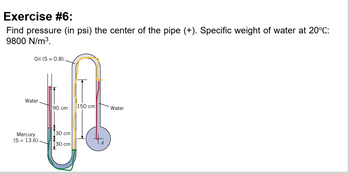
Structural Analysis
6th Edition
ISBN: 9781337630931
Author: KASSIMALI, Aslam.
Publisher: Cengage,
expand_more
expand_more
format_list_bulleted
Concept explainers
Question

Transcribed Image Text:Exercise #6:
Find pressure (in psi) the center of the pipe (+). Specific weight of water at 20°C:
9800 N/m³.
Oil (S = 0.8)
Water
Mercury
(S = 13.6)
90 cm
30 cm
30 cm
150 cm
Water
Expert Solution
This question has been solved!
Explore an expertly crafted, step-by-step solution for a thorough understanding of key concepts.
This is a popular solution
Trending nowThis is a popular solution!
Step by stepSolved in 4 steps with 3 images

Knowledge Booster
Learn more about
Need a deep-dive on the concept behind this application? Look no further. Learn more about this topic, civil-engineering and related others by exploring similar questions and additional content below.Similar questions
- Q3. Water flows through pipes A and B. Lubricating oil is in the upper portion of the inverted U, Mercury is in the bottom of the manometer bends. Determine the pressure difference, pA-pB in units of kPa. B Oil 0:25 m 25 cm H,0-10 cA H,0 20 cA 507 13 cn 15 Rotmarrow_forward3-153 A gasoline line is connected to a pressure gage through a double-U manometer, as shown in Fig. P3–153. If the reading of the pressure gage is 260 kPa, determine the gage pressure of the gasoline line. Oil SG = 0.79 P gage 260 kPa Gasoline SG = 0.70 45 cm 50 cm Pipe Air- 22 cm 10 cm Water - Mercury SG = 13.6arrow_forward3. What is the pressure difference between pipe A and pipe B? Give pressure difference in kPa. (y = 1.22 m and h 30 in.) The gage fluid, M, is mercury with a specific gravity of 13.54 State assumed values if any. Water A Water B y D Liquid Marrow_forward
- a. Determine the pressure at the interface of water and syrup.b. Determine the difference in pressure between the interface of water and syrup and the interface of carbon tetrachloride and syrup. c. Compute the hydrostatic pressure (in psi) acting at the bottom of the tank.d. Apply the PANEL EQUATIONS to determine the magnitude, direction and location of the total hydrostatic force acting at the bottom of the tankarrow_forwardA 1-m³ volume of water is contained in a rigid container. Estimate the change in the volume of the water when a piston applies a pressure of 33 MPa. m³arrow_forwardA tank contains oil (sp. gr. = 0.8), gasoline (sp. gr. = 0.9) and sea water with specific gravity of 1.05. Depth of liquids are 0.5, 0.6 and 0.8 m, respectively. 1. What is the pressure at a depth of 1.2 m below liquid surface? 2. Compute the pressure at the bottom of the tank. 3. What is the pressure at the midheight of the tank?arrow_forward
arrow_back_ios
arrow_forward_ios
Recommended textbooks for you

 Structural Analysis (10th Edition)Civil EngineeringISBN:9780134610672Author:Russell C. HibbelerPublisher:PEARSON
Structural Analysis (10th Edition)Civil EngineeringISBN:9780134610672Author:Russell C. HibbelerPublisher:PEARSON Principles of Foundation Engineering (MindTap Cou...Civil EngineeringISBN:9781337705028Author:Braja M. Das, Nagaratnam SivakuganPublisher:Cengage Learning
Principles of Foundation Engineering (MindTap Cou...Civil EngineeringISBN:9781337705028Author:Braja M. Das, Nagaratnam SivakuganPublisher:Cengage Learning Fundamentals of Structural AnalysisCivil EngineeringISBN:9780073398006Author:Kenneth M. Leet Emeritus, Chia-Ming Uang, Joel LanningPublisher:McGraw-Hill Education
Fundamentals of Structural AnalysisCivil EngineeringISBN:9780073398006Author:Kenneth M. Leet Emeritus, Chia-Ming Uang, Joel LanningPublisher:McGraw-Hill Education
 Traffic and Highway EngineeringCivil EngineeringISBN:9781305156241Author:Garber, Nicholas J.Publisher:Cengage Learning
Traffic and Highway EngineeringCivil EngineeringISBN:9781305156241Author:Garber, Nicholas J.Publisher:Cengage Learning


Structural Analysis (10th Edition)
Civil Engineering
ISBN:9780134610672
Author:Russell C. Hibbeler
Publisher:PEARSON

Principles of Foundation Engineering (MindTap Cou...
Civil Engineering
ISBN:9781337705028
Author:Braja M. Das, Nagaratnam Sivakugan
Publisher:Cengage Learning

Fundamentals of Structural Analysis
Civil Engineering
ISBN:9780073398006
Author:Kenneth M. Leet Emeritus, Chia-Ming Uang, Joel Lanning
Publisher:McGraw-Hill Education


Traffic and Highway Engineering
Civil Engineering
ISBN:9781305156241
Author:Garber, Nicholas J.
Publisher:Cengage Learning